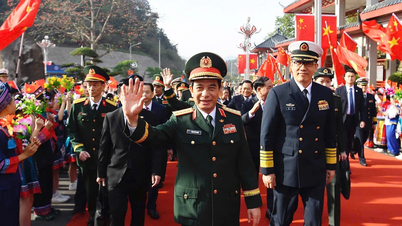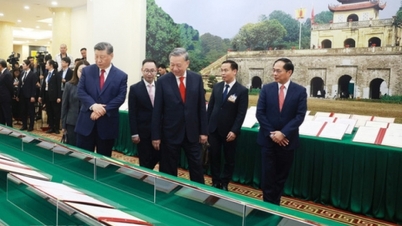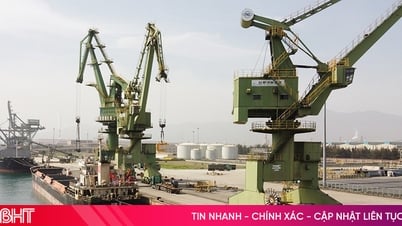In 2017, China announced an ambitious development program with the goal of becoming a global “AI innovation hub” by 2030.
AI is one of the most talked about keywords in 2023, but China has already laid out a grand strategy six years ago. In the 13th National Five-Year Plan in 2016, the country launched the "New Generation AI Development Plan", which began to be implemented and promoted from 2017. In it, China aims to achieve "world-leading level" by 2025 and become "the world's major AI innovation center" by 2030, prioritizing AI as the main driving force for industrial upgrading and economic transformation.

Illustration of China's AI-integrated humanoid robot. Photo: CryptoSlate
To achieve this goal, China promotes data sharing, encourages collaboration between academia and industry, and attracts foreign talent and investment. The government also encourages the integration of AI in a number of areas such as health care, transportation, and finance. Abundant data resources play an important role in the development of AI. Initiatives such as the National Engineering Laboratory for Big Data Analysis and Application have facilitated the use of data in AI research.
In addition to government and business push, a driving force for China’s AI industry comes from its own people. In a 2022 Stanford survey, 78% of Chinese respondents agreed that AI products and services have more benefits than drawbacks. Meanwhile, only 35% of Americans surveyed were optimistic about AI applications.
Great Achievement
Statistics released at the 2020 World Internet Conference in late November 2020 in Zhejiang Province showed that in 2019, China had more than 30,000 AI patents, up 52.4% from the previous year and surpassing the US in the number of new applications. This milestone marks the first time since 1978 that the US has lost its leading position in the number of patents and new inventions.
Before the world focused on AI as it does today, China was a pioneer in applying technology to real life. In 2017, the year of the policy of promoting artificial intelligence, China installed 20 million AI cameras to monitor the streets. They were deployed in all areas, from helping to enhance security, supporting crime prevention to optimizing traffic flow and reducing congestion, optimizing shopping, and developing education.
Notable products include Baidu's DuerOS integrated into electronic devices such as smart speakers; Tencent's WeChat AI supports automatic chat, content recommendation, and mobile payment services; SenseTime, Yitu Technology develops solutions for visual recognition technology in smart security monitoring systems, facial recognition, and medical applications; iFlyTek with natural language voice recognition systems.
Next-generation AI technology is also becoming popular in self-driving cars. Many cities in China are deploying or testing robotaxi at various stages. For example, in some areas of Beijing, Wuhan, and Chongqing, people can call a self-driving car with just a few taps on their smartphones. Baidu and Pony.ai have been licensed to operate robotaxi at prices competitive with traditional services.

Digital image simulation of a woman using AI technology. Photo: EPA-EFE
This year, amid the generative AI craze, domestic companies such as Baidu, Alibaba and ByteDance have also continuously launched large language models (LLMs) to compete with systems from the West.
In March, Baidu launched its chatbot Ernie. A month later, Alibaba unveiled Tongyi Qianwen, which has been described as “China’s version of ChatGPT.” SoftBank-backed SenseTime also introduced its large language model SenseNova and integrated it into a chatbot called SenseChat.
In early November, Beijing-based AI startup Baichuan announced that its self-developed AI model Baichuan2-192k was able to process about 350,000 Chinese characters, becoming the world's most powerful model in processing long text statements.
Also in November, 01.AI, a startup founded by computer scientist Lee Kai-Fu in March, became a tech unicorn, or valued at more than $1 billion, after announcing its LLM called Yi-34B. The platform, which supports English and Chinese, is said to outperform leading open-source models on the market, including Meta's Liama 2, thanks to its ability to handle 100 billion parameters, the largest of any open-source model to date and can compete directly with OpenAI's GPT-4, according to the Straitstimes .
“Our proprietary model will be benchmarked against GPT-4,” Kai-Fu said.
Reuters quoted Baidu CEO Robin Li as saying that as of early September, more than 70 large language models with over a billion parameters had been released in China. According to brokerage CLSA, China had at least 130 LLMs by the end of October, accounting for 40% of the global total and second only to the US with a 50% market share. In addition, companies have announced dozens of industry-specific LLMs.
In addition to AI models, China is also starting to become self-sufficient in hardware. In mid-November, Tsinghua University announced that it had successfully created a new AI chip that is 3.7 times more powerful than Nvidia’s A100 in computer vision tasks. Called ACCEL, the chip leverages photonic and sequential computing capabilities in a specialized architecture that operates on light and uses photons to handle high-speed information transmission.
Tsinghua University’s achievement will spur China’s research into optical computing chips to replace current electronic chips, as well as new AI chips in the future, a veteran chip industry source told SCMP . “In some cases, the performance from photonic computing is much stronger than electronic computing,” the person said.
"This year, China's AI industry has witnessed unprecedented breakthroughs. Thanks to policy support, China has entered a period of rapid development. China's major AI models are competing head-to-head with Western models," Global Times quoted independent technology expert Liu Dingding as saying.
Bao Lam - Vnexpress.net


![[Photo] Prime Minister Pham Minh Chinh chairs conference on anti-smuggling, trade fraud, and counterfeit goods](https://vphoto.vietnam.vn/thumb/1200x675/vietnam/resource/IMAGE/2025/5/14/6cd67667e99e4248b7d4f587fd21e37c)




































































































Comment (0)